Fried Quinoa
made in the style of Fried Rice, plus my honest thoughts about my MILL food recycler.
Welcome to To Vegetables, With Love, a celebration of a vegetable life, less ordinary. ‘ Find archived recipes on my recipe index.
My book Tenderheart is available from Books are Magic, Kitchen, Arts and Letters, Book Larder, Bold Fork Books and also here or here.
This week’s recipe is unlocked for all subscribers. Strap yourselves in, it’s a big one!
A quick shout out to for organizing a TENDERHEART cookbook club where HUNDREDS of readers cooked from the book. Read all about it here - I’m particularly interested in all the comments and subs/customizations that readers made…I’ve never had such a huge volume of direct feedback before. Check out for future cookbook clubs too! Thanks to Helen and all Culture Study readers for so generously welcoming me into your kitchens.
A few months ago, we welcomed a new member to our family. We named her George Mill-chael (after George Michael, duh).
While we refer to George by name, she is not human, but a food recycler. She is a Mill, an aesthetically pleasing, minimally designed bin that is just for food scraps. Her remit is simple: add your food scraps, and Mill will dehydrate and grind them up into a fine powder.
George has completely changed our lives. As a person who cooks several meals a day, I have a lot of food scraps. When I’m recipe testing, I’m filling several compost bags a day. When you consider I’m dealing exclusively in vegetables, my food waste is even greater than most. Even though we are in a part of Brooklyn that offers weekly curbside composting, the amount of food waste felt overwhelming. When I heard about Mill, I was very, very interested.
Mill has transformed my cooking routine and habits. Instead of filling up bowls and compost bags with scraps, I slide vegetable trimmings, peel, and wilted leaves straight into the Mill. My kitchen is more orderly and smells better too! No more rotting food waiting for us to take it down to the compost bin.
I have been using MILL for about two months now. I am surprised by how much my behaviour around food consumption has changed. I’ve never considered myself a wasteful person, but MILL has encouraged me to think more critically about what I buy and whether I really need it. In a way, the MILL holds me accountable. This could be as simple as purchasing one less chili pepper (I tend to just grab a handful), picking out 2 cucumbers instead of grabbing a whole bag, or reconsidering whether I need ALL the herbs in my basket. One of the hardest things to do in life is to change habits, so I’m grateful for this opportunity to check my own behaviour.
It's important to differentiate that MILL is not a composter but a food recycler. The grounds that come from MILL are nutrient-rich matter that can be composted, fed to animals, or added to home compost piles to feed soil. There’s more information here on food recycling and how the grounds can be used.
Personally, I empty the grounds straight into my curbside compost bin. For those without the convenience of curbside composting, MILL also offers a service where the grounds can be sent Mukilteo, WA where they are inspected, processed and turned into food for chickens. Mill works with a number of small farm partners (you can read more here).
A few useful things to know. There’s a handy MILL app that allows you to set a ‘grind and dry’ schedule to suits your lifestyle (mine goes on at midnight, after the kitchen has finally been cleaned and dishwasher has been stacked). I also love the food library which offers a comprehensive list of foods and whether they can be recycled (and I mean comprehensive…it was handy when I was wondering whether mochi could be recycled). The app also shows your impact and the amount of food waste you have saved. So far, at the time of writing, I have saved 68 pounds of food waste since February.
The other question many of you may have is about energy consumption. This is something I was worried about when I first started using MILL, but I have been pleasantly surprised by the fact that I have seen no increase in my energy bills. On the app, you can also see your energy usage. A typical Mill uses ~0.7 kWh/day. In comparison, a dishwasher is ~1.2-1.8 kWh per load (2x energy usage of Mill). Impressive!
A side note, one of the favourite things about MILL is the smell of my grounds. While the unit itself is completely odorless, the grounds themselves have an unique smell. Mill cofounder Harry Tannenbaum tells me that many Mill users have reported pleasing aromas from their grounds. It makes sense that the terroir of each person’s grounds will reflect what scraps are going in. My grounds smell emphatically of umami, and specifically, Chinese dried shiitake mushrooms!
If you’d like more information, check out my Earth Day chat with MILL co-founder Harry Tannenbaum here. MILL has also offered a discount to To Vegetables, With Love readers – click here for all the details.
This week’s newsletter is sponsored by MILL, however all opinions and views are my own. I only ever promote products and services that I personally use myself. Mill’s support of To Vegetables, With Love ensures that I can continue my work in bringing you a weekly newsletter with original recipes with independent thought and writing. Thank you Mill.
All NYT Cooking recipes have gift links:
Monday: Dumpling noodle soup
Tuesday: Tofu and Tomato Egg Drop Soup
Wednesday: Snap Pea, Tofu and Herb Salad With Spicy Peanut Sauce
Thursday: Hoisin garlic noodles, another new, super simple, pantry friendly recipe!
Friday: Warm Roasted Carrot and Barley Salad
🥦 My cookbook, Tenderheart is for cooking vegetables, all year round. Pick up your copy here. It is also mostly vegan (or vegan-izable) and gluten-free adaptable.
Fried Quinoa
© Hetty Lui McKinnon for To Vegetables, With Love.
While fried rice is often positioned as the quintessential ‘fridge-cleanout’ dish, I rarely think of it this way. I tend to stick to what I know, which is a Cantonese style fried rice with softly scrambled eggs and frozen vegetables (peas, corn, carrots). My fried rice, a descendent of my mother’s version, is light on soy sauce and generous with the salt. It is heavy with fruity white pepper and liberal with scallions. I rarely deviate, other than to add Spam or lap cheong (Chinese sausage) for my boys.
This week, I gave myself license to play with the concept of fried rice, because it is indeed a dish that is highly adaptable, and meets you where you are. In the spirit of reducing food waste, I decided to use up some leftover quinoa in the fridge, along with one of the several heads of lettuce I had languishing in the crisper. I also called upon the frozen corn and peas that is always in my freezer. The result is fried quinoa, made in the style and flavour of my Canto fried rice. I love the textures of this dish, at once familiar but completely new too. The quinoa is lighter and airier than rice. For those who seek ‘protein’, it offers plenty of that too.
Garlic and onion are not usual additions to my fried rice, but I had half an onion to use up and I enjoyed the extra aroma of the garlic here (okay to omit if you don’t have any).
I’ve included instructions to make the quinoa from scratch here. If you have leftover quinoa, you’ll need about 3 cups. Of course, you could use leftover rice here or other grains such as pearl barley or farro
Serves 4
Vegan and gluten free
200g (1 cup) quinoa
2 cups vegetable stock or water
neutral oil
1/2 - 1 onion, any color, halved and sliced
1 inch piece ginger, peeled and finely chopped
2 cloves garlic, finely chopped
135g (1 heaped cup) frozen peas
125 (1 heaped cup) frozen corn
285g (10 oz) lettuce, such as escarole or romaine/cos, trimmed and thinly sliced
1 tablespoon soy sauce or tamari
Sea salt and white pepper
2 scallions, trimmed and thinly sliced
crispy fried onions/shallots, for serving (optional)
Substitute:
Onion: leeks
Frozen peas/corn: frozen mixed vegetables, fresh corn and peas, carrot, celery
Lettuce: other greens such as spinach, kale, chard, bok choy, cabbage
Place the quinoa and vegetable stock or water in a medium pot (if using water, season with 1 teaspoon of salt). Bring to the boil, reduce the heat to medium–low, cover and cook until the quinoa is translucent and tender, and the liquid has been absorbed, about 15 minutes. Remove the lid and allow to cool for 10 minutes.
Heat a wok or large skillet (frying pan) on medium high heat for 2 minutes. Drizzle with 1 to 2 tablespoons neutral oil and add the onion and toss until slightly softened, 1 to 2 minutes. Add the ginger and garlic and toss until fragrant, about 30 seconds. Add the quinoa, toss and then allow to cook undisturbed for 1 to 1 1/2 minutes, allowing the quinoa to crisp up slightly. Add the peas, corn, lettuce, soy sauce or tamari and toss until the quinoa and the vegetables are warm and the lettuce is wilted, about 2 minutes. Taste and season with salt and lots of pepper.
Turn off the heat and add the scallions and crispy fried onions/shallots, if using.

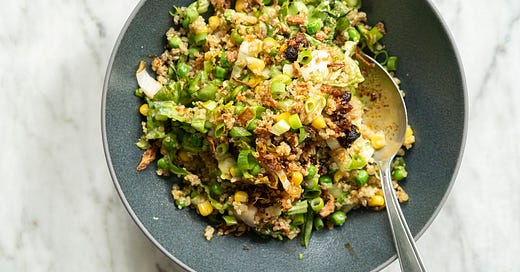


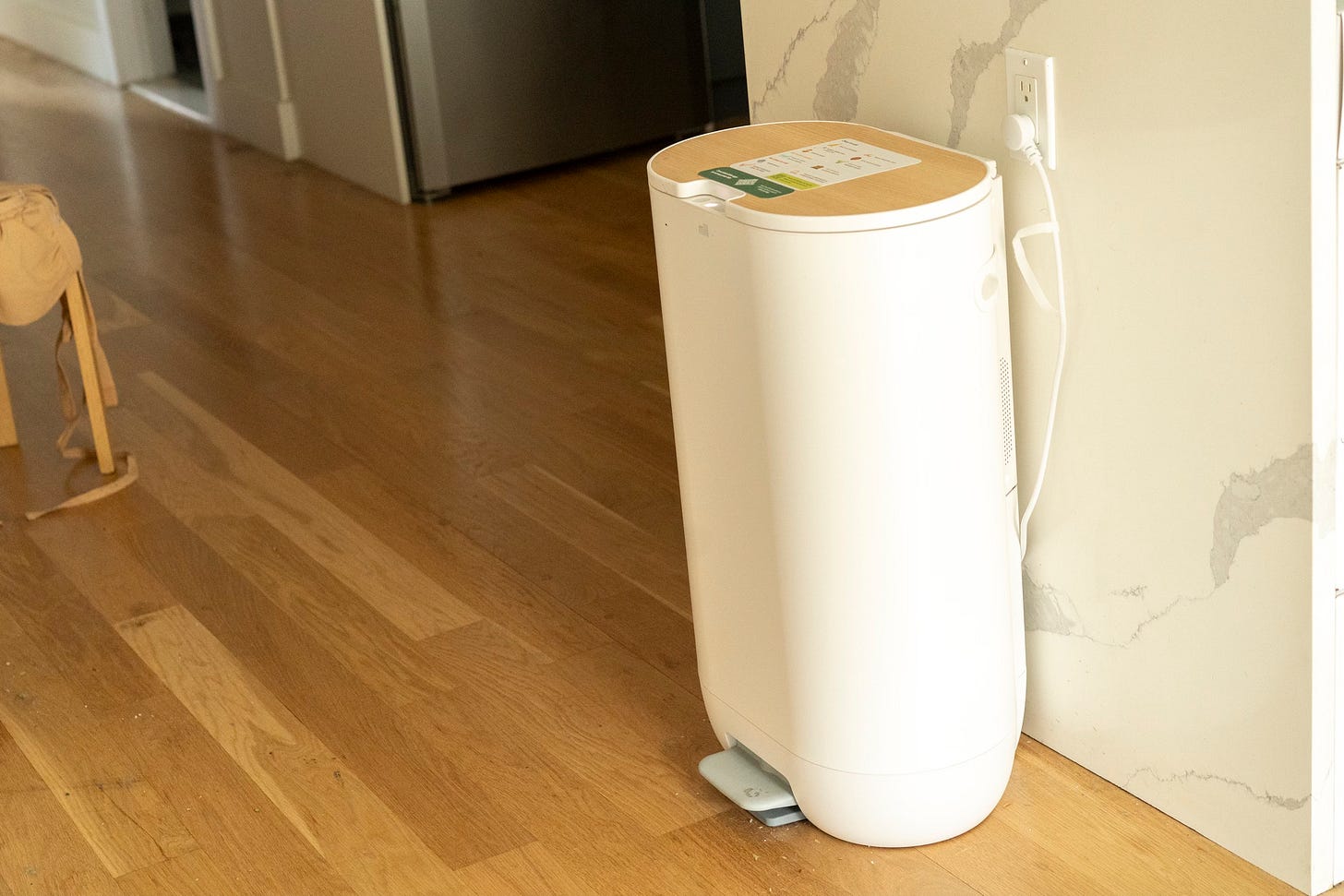




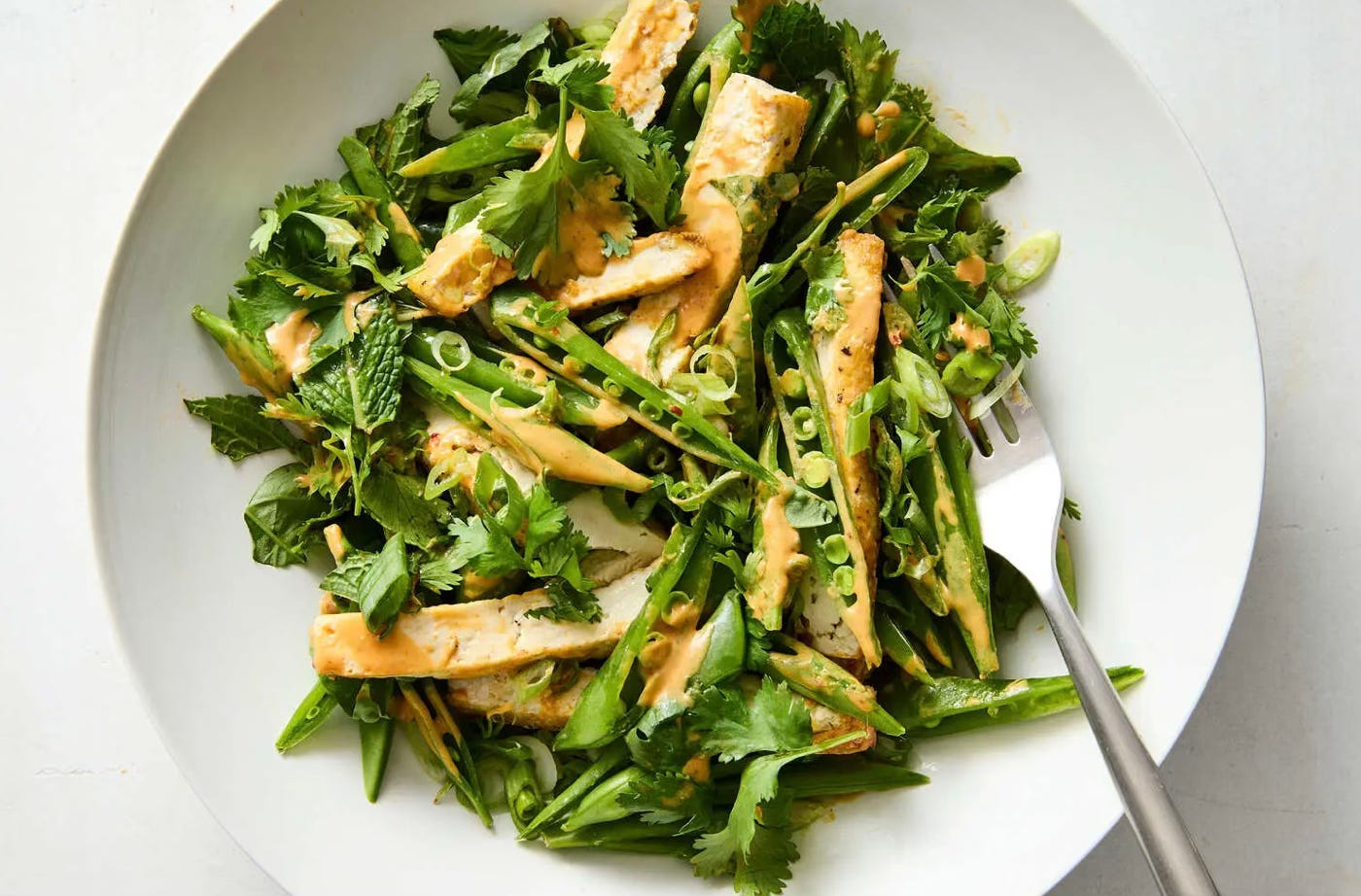
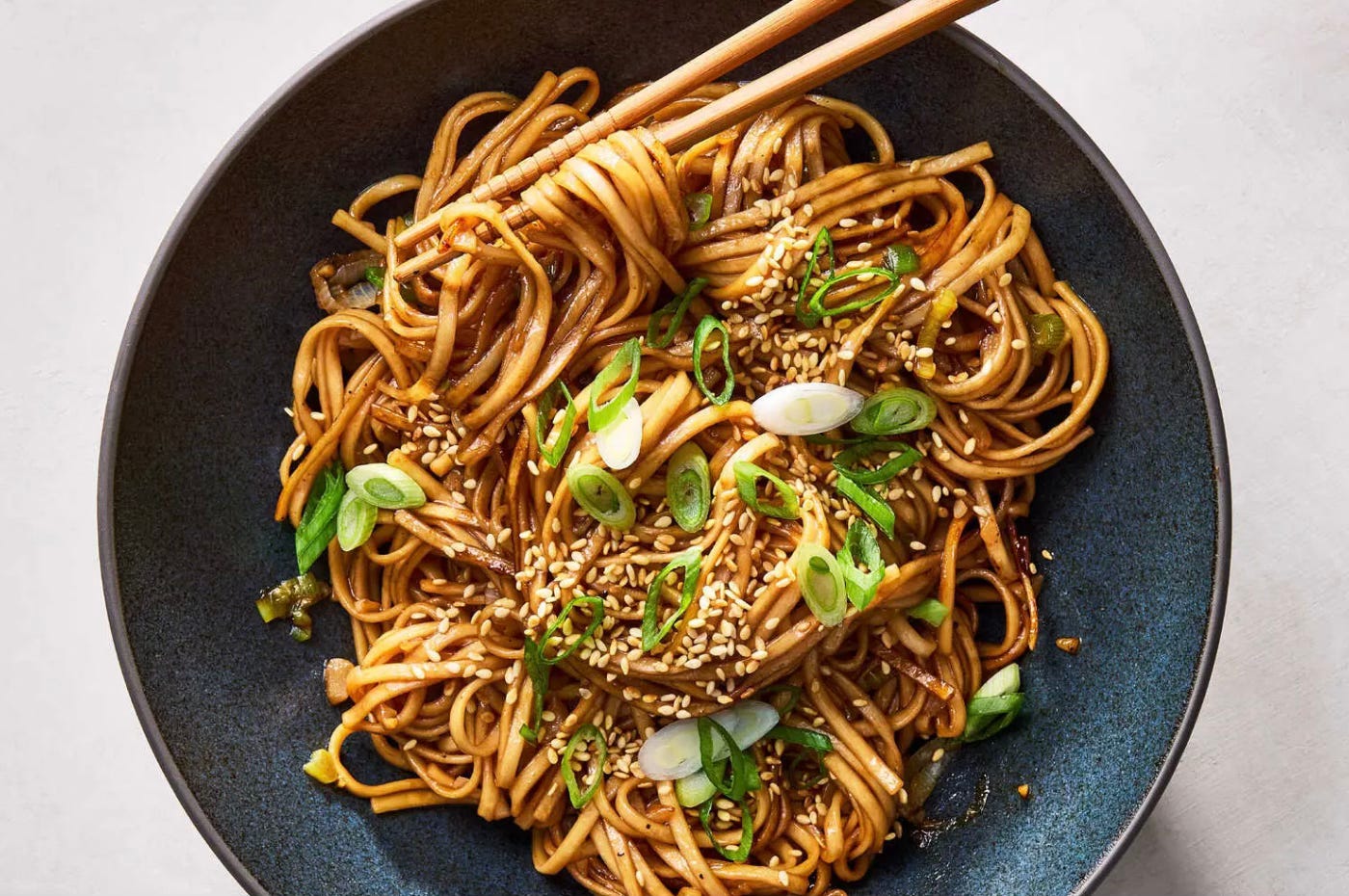



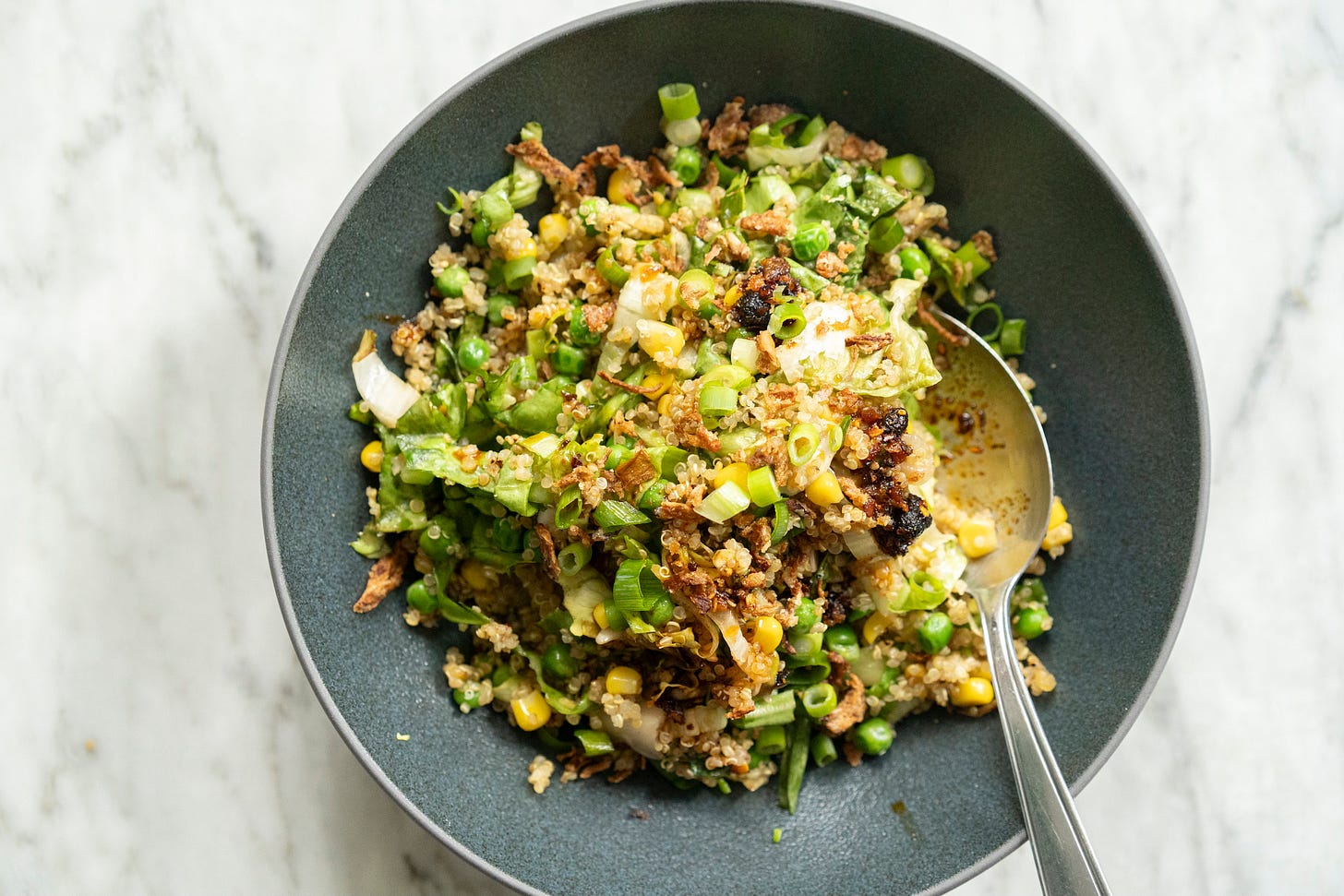
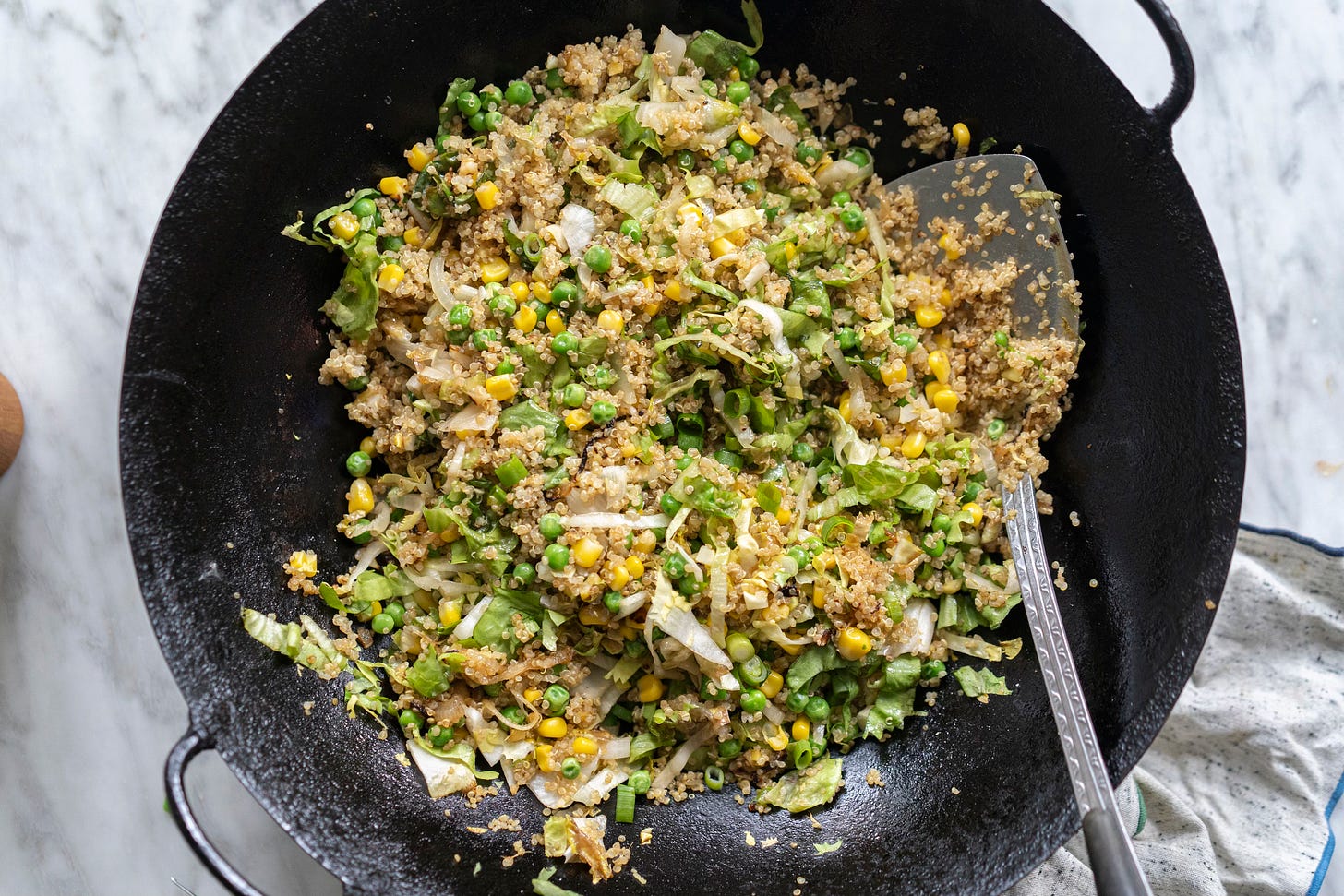
I can’t wait to try this, I’ve been looking for more quinoa recipes. Thank you!
Funny timing as I was just making variations of left over fried rice cakes and thinking....why not with quinoa? Did you know that "crunchy" is the most preferred flavor/texture? Yum!